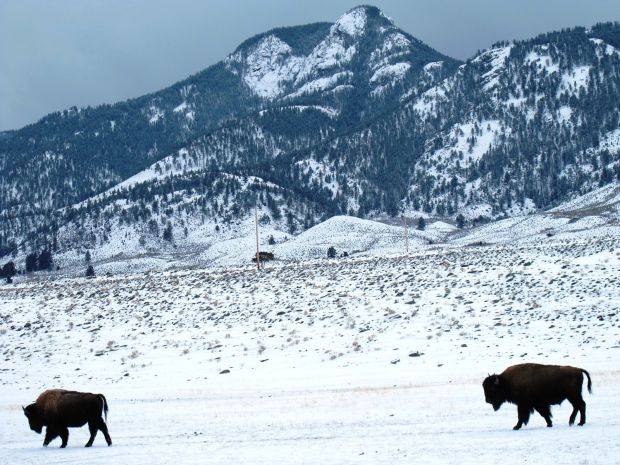Billings Gazette Feb 19, 2014 • By Brett French

Bison wander back toward Yellowstone National Park from outside the park’s northern border in the Gardiner Basin recently. The park continues to ship bison to slaughter to reduce the number of animals in the park.
The Confederated Salish and Kootenai Tribes trucked 17 more Yellowstone National Park bison from the park’s Stephens Creek bison capture facility to a slaughter facility in Ronan on Wednesday.
The tribes pay a game warden to ride along with the shipment of animals to shoot them if there is an accident and the bison escape from the trailer, a requirement of the Montana Department of Livestock.
That requirement was unknown to the Inter Tribal Buffalo Council, which had agreed to take any bison not wanted by Yellowstone treaty tribes. Initially, the DOL offered to provide one of its employees to ride along at a cost of $350 a trip. When the council balked at the cost, Yellowstone on Wednesday agreed to pay, said Christian Mackay, executive officer for the DOL.
“It’s not an insurmountable problem by any means,” Mackay said. “We have some loads scheduled this week to go out.”
Jim Stone, executive director of the buffalo council, said such “annoying” issues are roadblocks to fulfilling agreements under the Interagency Bison Management Plan and he called into question the DOL’s role in the process.
To date, tribal and state hunters have killed 162 bison, said Tom McDonald of the confederated tribes’ natural resources office. The Nez Perce, Shoshone-Bannock and Umatilla tribes are still conducting hunts. Montana-licensed hunters took 29 bison this season.
Last week, the confederated tribes transported another 20 bison from Yellowstone to slaughter and five were transferred to the USDA Animal and Plant Health Inspection Service for research. According to a Park Service spokesman, about 70 to 75 bison are now in the Stephens Creek corral. The bison were not hazed into the facility. Another 50 to 70 bison have moved past the park’s northern boundary in the Gardiner Basin while about 400 have gathered in the park roughly between the towns of Gardiner and Mammoth Hot Springs, Wyo.
Yellowstone officials want to remove 300 to 600 bison in consecutive years to reduce the size of the park’s herds to meet the terms of an agreement with the state of Montana. Bison advocacy groups have decried the move, saying a target population of 3,000 to 3,500 bison in the park is not based on the carrying capacity of the range. This summer the park’s bison herd was estimated at 4,600 animals.
Bison advocates would like to see the animals given more room to roam outside Yellowstone and a quarantine process enacted to transfer live animals to existing tribal bison herds. Those efforts have been fought by the livestock industry since many of the bison carry brucellosis, which can cause pregnant cattle to abort.
Defenders of Wildlife said 56,000 people had emailed Gov. Steve Bullock asking him to intervene and halt the slaughter.
McDonald said confederated tribes are taking bison to slaughter for hunters who were unsuccessful in filling their bison hunting tags. The hunters pay for the cost of shipping, slaughtering and butchering of the bison.
“When it’s all said and done, people love bison meat and are willing to pay a premium,” McDonald said. “Ninety-seven percent of the people who return to eating bison find it exceptional.”
He added that the hunts have been “self-esteem builders” for the parties of hunters that travel to Yellowstone’s borders.
“It’s almost a healing kind of thing,” McDonald said.
